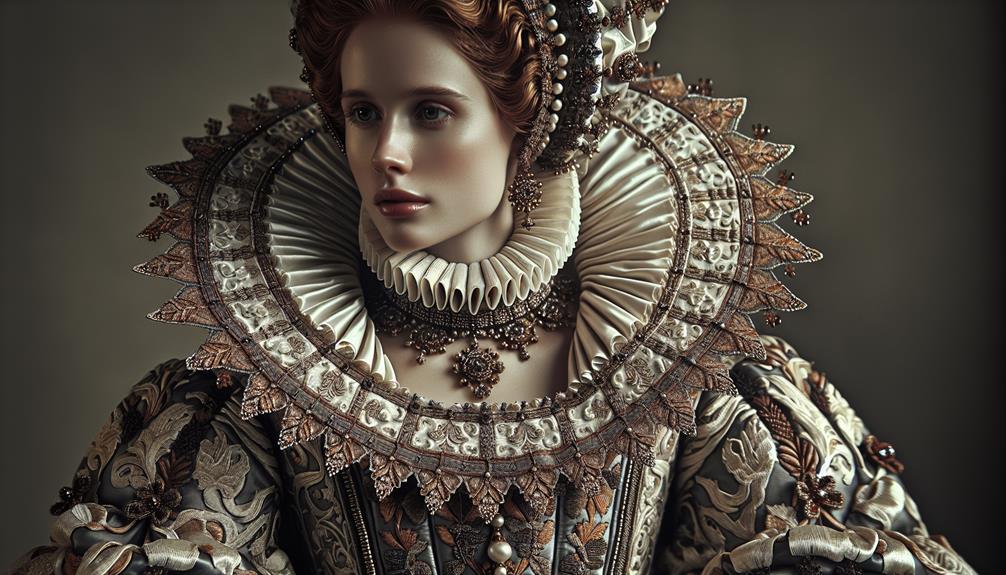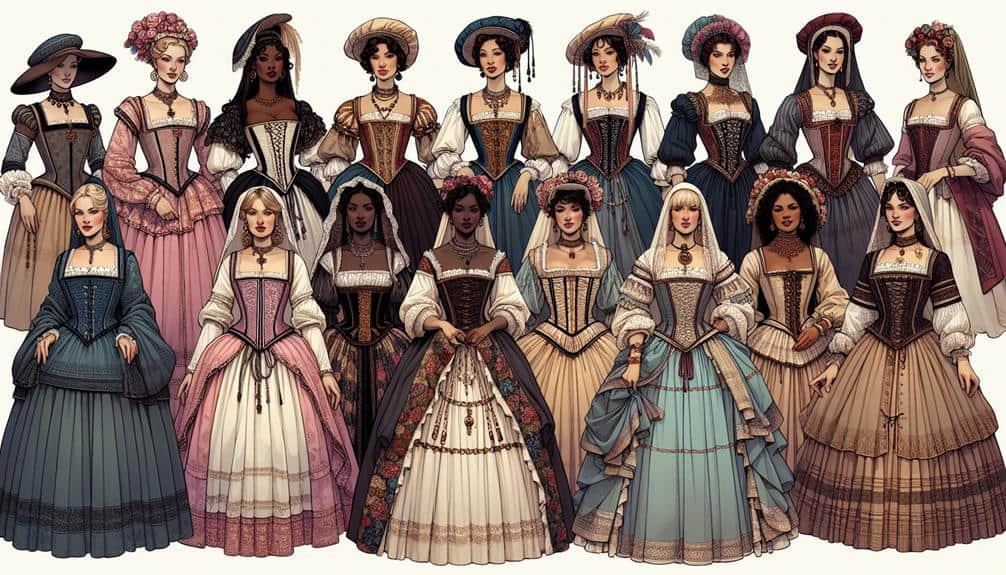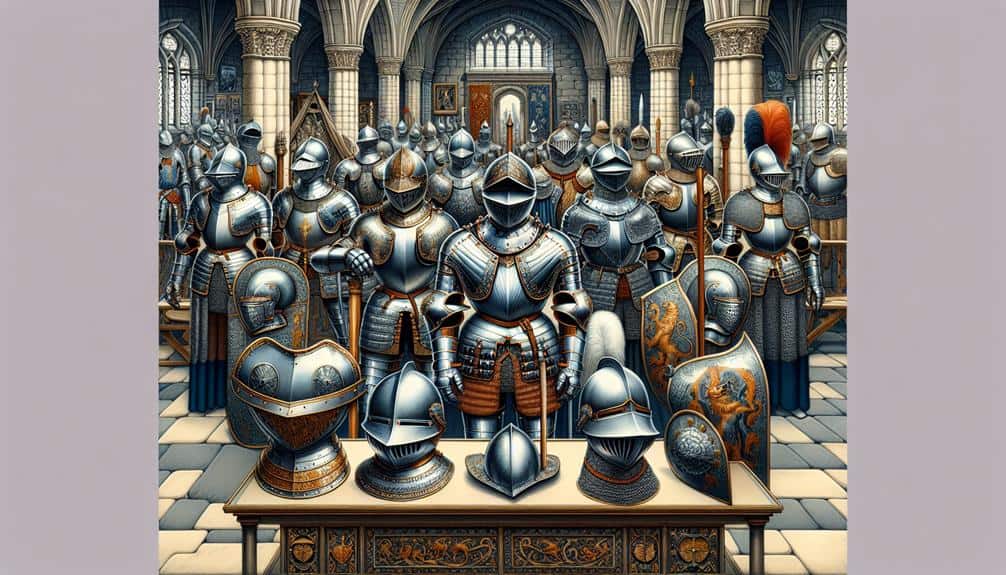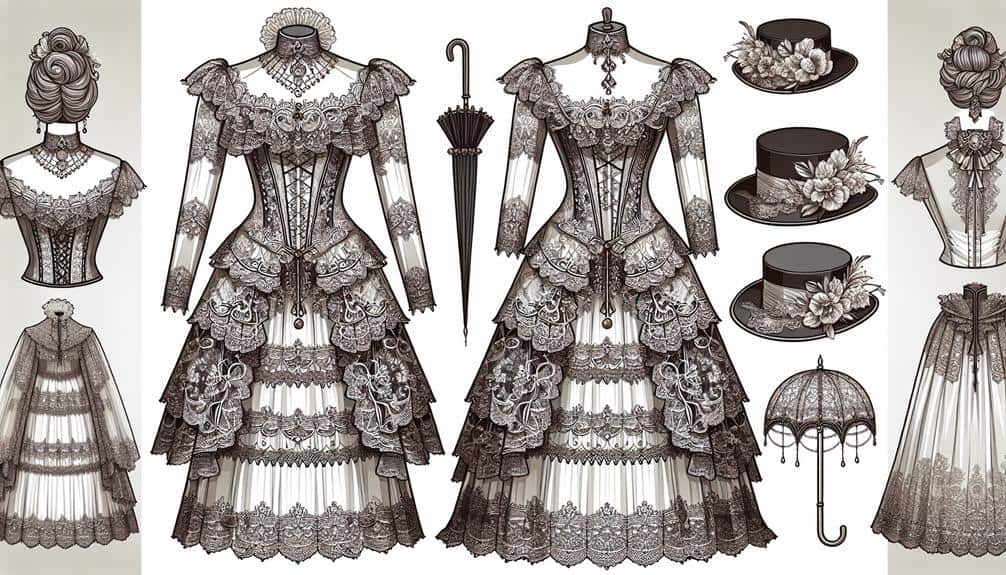Embark on a journey through the opulent world of Elizabethan Court fashion, where sumptuous silks, intricate embellishments, and regal ruffs reign supreme.
Discover how the clothing choices of this era were not just mere garments but statements of power, wealth, and social standing.
As you navigate through the intricate details of attire fit for royalty, prepare to be transported back in time to an era where fashion was not just a choice but a reflection of one's place in society.
Explore the intricacies of Elizabethan Court fashion and reveal the secrets behind these elaborate ensembles that continue to captivate and inspire even today.
Key Takeaways
- Court etiquette heavily influenced Elizabethan fashion choices.
- Garments reflected social status and adherence to etiquette norms.
- Queen Elizabeth I set significant fashion trends of the era.
- High-necked gowns in rich fabrics like silk and velvet were popular among women.
Elizabethan Court Fashion Essentials
When exploring Elizabethan court fashion essentials, understanding the intricate layers and fabrics is essential for capturing the essence of the era's style. Court etiquette played a significant role in shaping fashion trends during this period. The elaborate garments worn at court weren't just for display but were also a reflection of one's social standing and adherence to etiquette norms.
Fashion trends in Elizabethan court were heavily influenced by Queen Elizabeth I herself. Her love for luxurious fabrics, intricate embroidery, and elaborate accessories set the tone for court fashion. Women were expected to wear high-necked gowns with fitted bodices and full skirts, often made of rich fabrics like silk, velvet, and brocade. Men, on the other hand, donned doublets, breeches, and hose, all tailored to accentuate a V-shaped silhouette.
Court etiquette dictated that clothing should be richly adorned to showcase one's wealth and status. Accessories such as ruffs, cuffs, and elaborate headpieces were commonly worn to complete the ensemble. Understanding these fashion essentials is important for anyone looking to authentically recreate Elizabethan court attire.
Authentic Materials and Fabrics
To truly embody the essence of Elizabethan court fashion, one must carefully select authentic materials and fabrics that mirror the opulence and grandeur of the era. When recreating this historical style, consider using the following key fabrics:
- Silk Brocade: This luxurious fabric was highly favored during the Elizabethan era for its intricate patterns and rich textures. Silk brocade was often used in elaborate gowns and doublets, adding a touch of extravagance to any ensemble.
- Velvet Gowns: Velvet was a popular choice for nobles and royalty due to its softness and sheen. Elizabethan courtiers often donned velvet gowns in deep, regal colors to showcase their status and wealth.
- Linen Chemises: Underneath the lavish outer garments, linen chemises were worn for comfort and practicality. These lightweight, breathable garments were essential for layering and maintaining hygiene in the elaborate Elizabethan wardrobe.
- Woolen Doublets: Doublets, a close-fitting jacket worn by men, were commonly made from wool during this period. Wool provided warmth and structure, making it a staple fabric for creating the structured silhouettes typical of Elizabethan fashion.
Accessories for Period Accuracy
For an authentic representation of Elizabethan court fashion, incorporating meticulously chosen accessories is essential to achieve period accuracy. Jewelry trends during the Elizabethan era were characterized by intricate designs, featuring pearls, gemstones, and intricate metalwork. Women often adorned themselves with elaborate necklaces, earrings, and rings to showcase their wealth and status. To emulate this look, opt for statement pieces with ornate detailing and rich colors.
When it comes to footwear options, both men and women in the Elizabethan court preferred shoes made of leather or velvet. Men typically wore low-heeled shoes with decorative buckles, while women sported heeled shoes with intricate embroidery and embellishments. To complete your Elizabethan ensemble, consider investing in a pair of leather or velvet shoes that feature classic Elizabethan elements like pointed toes and decorative accents.
Hairstyles and Headpieces
In exploring Elizabethan court fashion authenticity, delving into Hairstyles and Headpieces reveals intricate details that complement the overall period look. During this era, hairstyles were an essential part of one's ensemble, often adorned with delicate tiaras and jeweled hairpins. Here's what you need to know about Elizabethan hairstyles and headpieces:
- Intricate Updos: Elizabethan women often wore elaborate updos, intricately styled to showcase their status and wealth. These updos were carefully constructed using braids, curls, and twists, creating a regal and elegant appearance.
- Delicate Tiaras: Tiaras were popular accessories worn by noblewomen at court. These delicate headpieces were adorned with pearls, gemstones, and intricate metalwork, adding a touch of luxury to the overall look.
- Elaborate Headdresses: Elizabethan fashion included a variety of elaborate headdresses, from tall, elaborate constructions adorned with feathers and veils to smaller, more intricate designs embellished with lace and ribbons.
- Jeweled Hairpins: Hairpins were essential for securing the elaborate hairstyles of the Elizabethan period. These hairpins were often embellished with jewels, adding a touch of sparkle and glamour to the overall look.
Makeup and Beauty Tips
Enhance your Elizabethan court fashion look with authentic makeup and beauty tips that capture the essence of the era's aesthetic. During the Elizabethan era, beauty standards revolved around a pale complexion, rosy cheeks, and a bold lip. To achieve this look, women used period cosmetics such as ceruse, a white lead-based powder, to whiten their faces. For flushed cheeks, a mixture of red ocher and vermilion was applied to create a natural blush effect. Dark and dramatic lips were fashionable, achieved by using lip colors made from natural ingredients like beeswax and plant dyes.
Makeup techniques in the Elizabethan court focused on creating a stark contrast between the pale skin and the brightly colored features. Women often plucked their eyebrows to create a higher, elongated brow arch, emphasizing the forehead, which was considered a sign of beauty during that time. Additionally, a widow's peak hairstyle was popular, framing the face and drawing attention to the eyes and lips. By following these historical trends and makeup techniques, you can authentically embody the beauty ideals of the Elizabethan court.
Frequently Asked Questions
How Did Elizabethan Court Fashion Influence the Clothing Styles of the Lower Classes During This Time Period?
Elizabethan court fashion heavily influenced the lower classes' clothing styles. The social hierarchy dictated that the wealthy nobility set the trends, while those of lower economic status emulated these fashions in more affordable versions to mirror status symbols.
Were There Any Specific Rules or Regulations Regarding the Color Choices for Clothing Worn at Court During the Elizabethan Era?
When dressing for court in the Elizabethan era, color restrictions were strictly enforced. Court attire dictated specific hues denoting social standing. For example, only royalty could wear purple, symbolizing power and wealth, while lower classes were limited to earth tones.
What Were Some Popular Trends in Footwear for Both Men and Women in Elizabethan Court Fashion?
In Elizabethan court fashion, footwear trends varied for men and women. Men often wore leather shoes with intricate designs, while women opted for ornate heels and embellishments. Comfort and style were key factors in choosing popular choices.
How Did the Clothing of Foreign Dignitaries and Ambassadors Differ From That of English Courtiers During the Elizabethan Era?
When foreign dignitaries graced the English court during the Elizabethan era, their attire exuded a blend of cultural influences and fashion diplomacy. Embassies donned regal garments rich in intricate designs, luxurious fabrics, and unique accessories.
Were There Any Restrictions on the Types of Jewelry That Could Be Worn at Court, and What Were Some Popular Choices for Both Men and Women?
When at court in the Elizabethan era, jewelry options varied. Discreet gemstones like pearls and diamonds were favored. Fashion etiquette dictated appropriate adornments. Symbolic accessories held significance. Men and women showcased royal jewels to display status, with intricate designs reflecting wealth and power.



